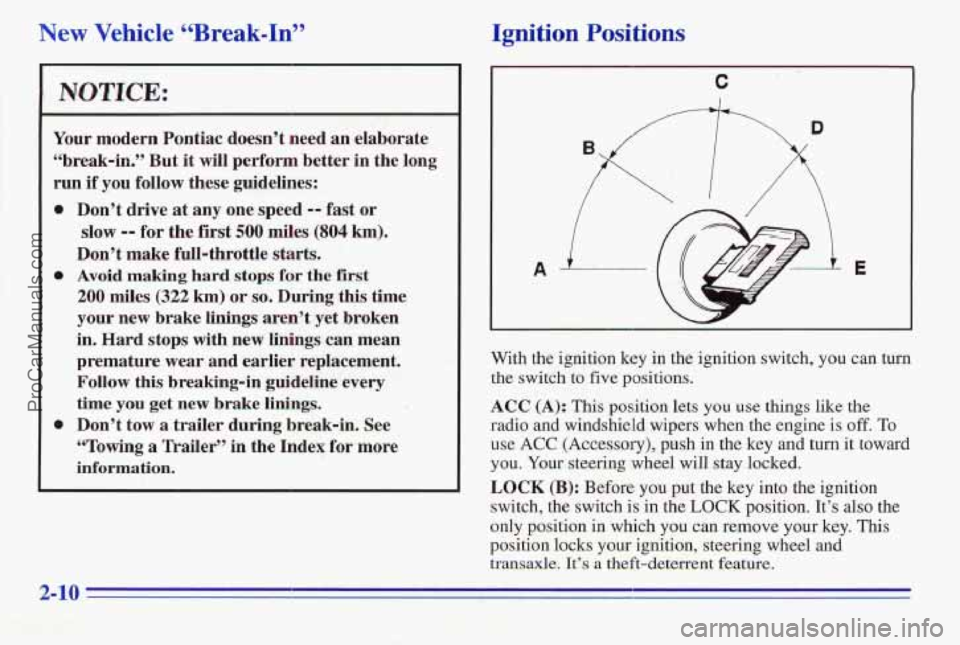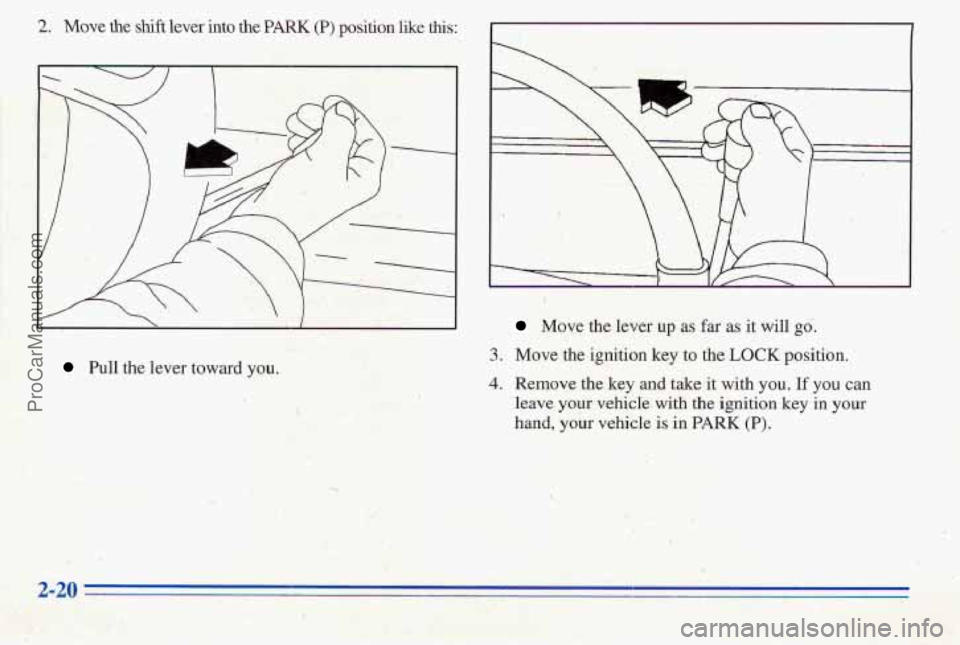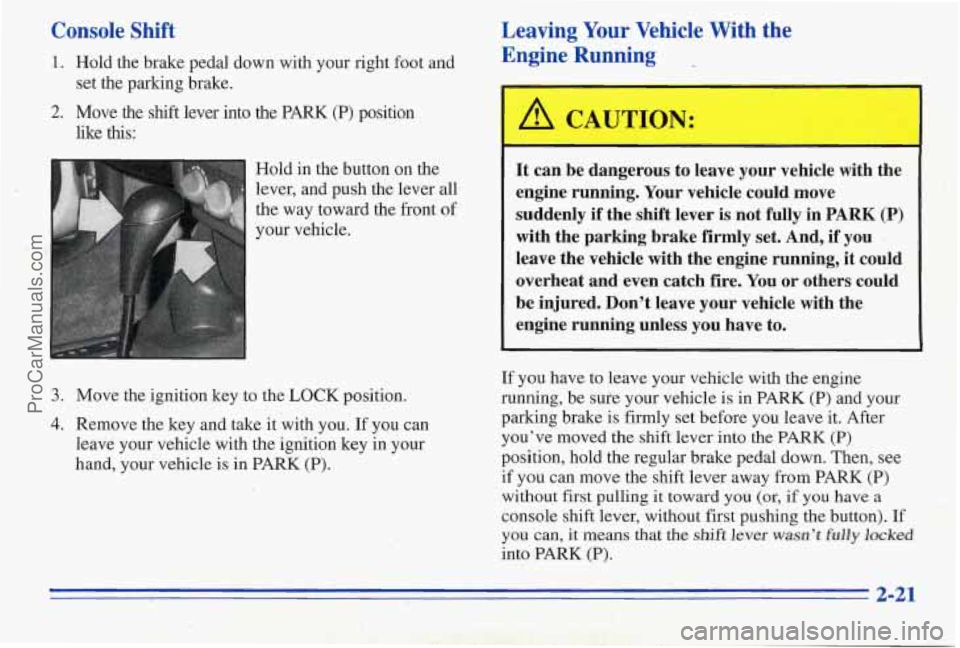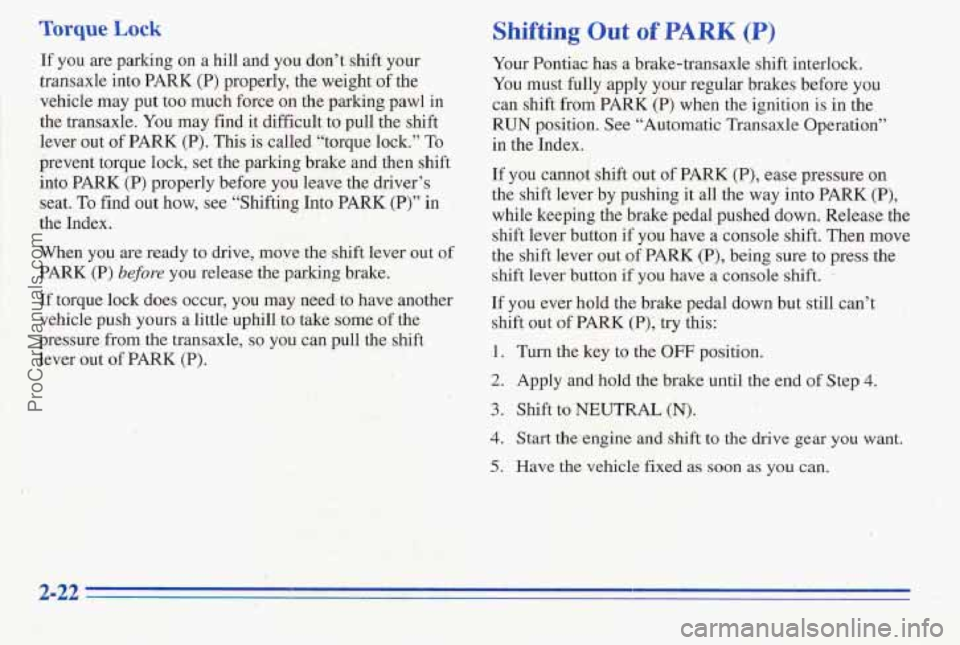1996 PONTIAC PONTIAC key
[x] Cancel search: keyPage 77 of 370

Theft
Vehicle theft is big business, especially in some cities.
Although your Pontiac has
a number of theft-deterrent
features, we know that nothing we put on it can make
it impossible to steal. However, there are ways you
can help.
Key in the Ignition
If you leave your vehicle with the keys inside, it’s an
easy target for joy riders or professional thieves
-- so
don’t do it.
When you park your Pontiac and open the driver’s door,
you’ll hear a chime reminding you to remove
your key
from
the ignition and take it with you. Always do this.
Your steering wheel will be locked, and so will your
ignition and transaxle., And remember to lock the doors.
Parking at Night
Park in a lighted spot, close all windows and lock your
vehicle. Remember
to keep your valuables out of sight.
Put them in
a storage area, or take them with you.
Parking Lots
If you park in a lot where someone will be watching
your vehicle, it’s best
to lock it up and take your keys.
But what if you have to leave your ignition
key? what if
you have to leave something valuable in your vehicle?
0 Put your valuables in a storage area, like your trunk
0 Lock the glove box.
Lock all the doors except the driver’s.
0 Then take the door key with you.
or
glove box.
PASS-Key@ I1
Your vehicle is equipped
with the PASS-Key
I1
(Personalized Automotive
Security System)
theft-deterrent system.
PASS-Key
I1 is a passive
tbeft-deterrent system.
It works when you insert
or remove the key from
the ignition.
I I I ”
PASS-Key 11 uses a resistor pellet in the ignition key
ProCarManuals.com
Page 78 of 370

When the PASS-Key I1 system senses that someone is
using the wrong key, it shuts down the vehicle’s starter
and fuel systems. For about three minutes, the starter
won’t work and fuel won’t
go to the engine. If someone
tries to start your vehicle again or uses another key
during this time, the vehicle will not start. This
discourages someone from randomly trying different
keys with different resistor pellets in an attempt to make
a match.
The ignition key must be clean and dry before it’s
inserted in the ignition or the engine may not start.
If the
engine does not start and the SECURITY light is on,
the
key may be dirty or wet. Turn the ignition off.
Clean and dry the, key. Wait about three minutes and try
again. The SECURITY light may remain on during this
time.
If the starter still won’t work, and the key appears
to be clean and dry, wait about
three minutes and try
another ignition key. At this time, you may also want to
check the fuse (see “Fuses and Circuit Breakers” in the
Index).
If the starter won’t work with the other key, your
vehicle needs ‘service. If your vehicle does start, the first
ignition key may
be faulty. See your Pontiac dealer or a
locksmith who can service
the PASS-Key 11.
If you accidentally use a key that has a damaged or
missing resistor pellet, the starter won’t work and the
SECURITY light will flash. But you don’t have to wait
three minutes before trying another ignition key.
See your Pontiac dealer
or a locksmith who can service
the PASS-Key
11 to have a new key made.
If you’re ever driving and
the SECURITY light comes
on, you will be able to restart your engine
if you turn
it off. Your PASS-Key 11 system, however, is not
working properly and must
be serviced by your
Pontiac dealer. Your vehicle is not protected by the
PASS-Key
I1 system.
If you lose or damage a PASS-Key
II ignition key,
see your Pontiac dealer or a locksmith who can service
PASS-Key I1 to have a new key made. In an emergency,
call the Pontiac Roadside Assistance Program at
1-800-ROADSIB or 1-800-762-3743.
2-9
ProCarManuals.com
Page 79 of 370

New Vehicle 66Break-InS’ Ignition Positions
Your modern Pontiac doesn’t need an elaborate
“break-in.” But
it will perform better in the long
run
if you follow these guidelines:
Don’t drive at any one speed
-- fast or
slow
-- for the first 500 miles (804 km).
Don’t make full-throttle starts.
Avoid making hard stops for the first
200 miles (322 km) or so. During this time
your new brake linings aren’t
yet broken
in. Hard stops with new linings can mean
premature wear and earlier replacement.
Follow this breaking-in guideline every
time
you get new brake linings.
Don’t tow a trailer during break-in, See
‘‘Towing a Trailer’’ in the Index for more
information.
C
A i E
With the ignition key in the ignition switch, you can twn
the switch to five positions.
ACC (A): This position lets you use things like the
radio and windshield wipers when the engine is
off. To
use ACC (Accessory), push in the key and turn it toward
you. Your steering wheel will stay locked.
LOCK (B): Before you put the key into the ignition
switch, the switch
is in the LOCK position. It’s also the
only position in which you can remove your key.
This
position locks your ignition, steering wheel and
transaxle. It’s a theft-deterrent feature.
ProCarManuals.com
Page 80 of 370

OFF (C): This position lets you turn off the engine but
still tuin the steering wheel. It doesn’t lock the steering
wheel like
LOCK. Use OFF if you must have your
vehcle pushed
or towed.
RUN (D): This position is where the key returns
after you start your vehicle. With the engine
off, you
can use
RUN to display some of your warning and
indicator lights.
: START (E): This position starts your engine.
A warning chime will sound
if you open the driver’s
door when the ignition is in the
OFF, LOCK or ACC
position and the key
is in the ignition.
NOTICE:
If your key seems stuck in LOCK and you can’t
turn it, be sure it
is all the way in. If it is, then
turn the steering wheel left and right while you
turn the key hard. But turn the key only with
your hand. Using
a tool to force it could break
the key or the ignition switch.
If none of this
works, then your vehicle needs service.
Starting Your Engine
Move your shift lever to PARK (P) or NEUTRAL (N).
Your engine won’t start in any other position -- that’s a
safety feature.
To restart when you’re already moving,
use
NEUTRAL (N) only.
NOTICE:
Don’t try to shift to PARK (P) if‘ your Pontiac
is moving.
If you do, you could damage the
transaxle. Shift to PARK
(P) only when your
vehicle is stopped.
1. Without pushing the accelerator pedal, turn your
ignition key
to START. When the engine starts, let
go of the key. The idle speed will go down as your
engine gets warm.
2-11
ProCarManuals.com
Page 81 of 370

NOTICE:
Hdding your key in START for longer than
15 seconds at a time will cause your battery to be
drained much sooner. And the excessive heat can
damage your starter motor.
2. If your engine won’t start (or starts but then stops),
it could be flooded with too
much gasoline. Try
pushing your accelerator pedal all the way to the
floor and holding it there as you hold the key in
START for up to 15 seconds. This clears the extra
gasoline from the engine.
4
NOTICE:
Your engine is designed to work with the
electronics in your vehicle.
If you add electrical
parts
or accessories, you could change the way
the engine operates. Before adding electrical
equipment, check with
your dealer. If you don’t,
your engine might not perform properly.
If’ you ever have to have your vehicle towed, see
the part
of this manual that tells how to do it
without damaging your vehicle. See “Towing
Your Vehicle” in the Index.
2-12
ProCarManuals.com
Page 89 of 370

2. Move the shift lever into the PARK (P) position like this:
I' 1
!
Pull the lever toward you..
Move the.lever up as far as it will go.
3. Move the ignition key to the LOCK position.
4. Remove the key and take it with you. If you can
leave your vehicle. with the
ignition key in your
hand, your vehicle is in PARK (P).
ProCarManuals.com
Page 90 of 370

Console Shift
1. Hold the brake pedal down with your right foot and
2. Move the shift lever into the PARK (P) position
set the parking brake.
like
this:
I Hold in the button on the
lever,, and push ‘the lever
all
the way toward the front of
3. Move the ignition key to the ‘LOCK position.
4. Remove the key and take it with you. If you can
leave your vehicle with the ignition
key in your
hand, your vehicle is in PARK (P).
. /. 1 ,‘r ,*
Leaving Your Vehicle With the
Engine Running
A CAUTION:
It can be dangerous to leave your vehicle with the
engine running. Your vehicle could move
suddenly
if the shift lever is not fully in PARK (P)
with the parking brake firmly set. And, if you I
leave the vehicle with the engine running, it could
overheat and even catch fire. You or others could
be injured. Don’t leave your vehicle with the
engine running unless you have to.
If you have to leave your vehicle with the engine
running, be sure your vehicle is in PARK (P) and your
parking brake
is firmly set before you leave it. After
you’ve moved the shift lever into the PARK
(P)
position, hold the regular brake pedal down. Then, see
if you can move the shift lever away from PARK (P)
without
first pulling it toward you (or, if you have a
console shift lever, without first pushing the button). If
you can, it means that the shift lever wasn’t fully locked
into PARK (P) .
2-21
ProCarManuals.com
Page 91 of 370

Torque Lock Shifting Out of PARK (P)
If you are parking on a hill and you don’t shift your
transaxle into PARK (P) properly, the weight of the
vehicle may put too much force on the parking pawl in
the transaxle. You may find it difficult to pull the shift
lever out
of PARK (P). This is called “torque lock.” To
prevent torque lock, set the parking brake and then shift
into PARK (P) properly before you leave the driver’s
seat.
To find out how, see “Shifting Into PARK (P)” in :.
the Index. I
When you are ready to drive, move the shift lever out of
PARK (P) before you release the parking brake.
If torque lock does occur, you may need to have another
vehicle push yours a little uphill
to take some of the
pressure
from the transaxle. so vou can pull the shift
lever out
of PARK (P).
1 .:
Your Pontiac has .a brake-transaxle shift interlock.
You must fully apply your regular brakes before you
can shift from PARK (P) when the ignition is in the
I RUN position. See “Automatic Transaxle Operation”
in the Index.
If you cannot shift out
of PARK (P), ease pressure on
, the shift lever by pushing it all the way into PARK (P),
. while keeping the brake pedal pushed down. Release the
.. . shift lever button if you have a console shift. Then move
the
shift lever out of PARK (P), being sure to press the
shift lever button
if you have a console shift. .
If y’ou ever hold the brake pedal down but still can’t
shift out of
PARK (PI; try this:
1. Turn the key to the OFF position.
2. Apply and hold the brake until the end of Step 4.
3. Shift to NEUTRAL (N).
4. Start the engine and shift to the drive gear you want.
5. Have the vehicle’ fixed as soon as you can.
ProCarManuals.com